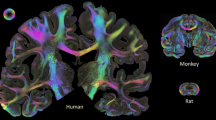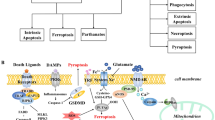Abstract
Hypertension is a leading cause of cerebral small vessel disease (CSVD) and vascular dementia in elderly individuals. We aimed to assess cerebral perfusion and dynamic changes in brain structure in stroke-prone renovascular hypertensive rats (RHRSPs) with different durations of hypertension and to investigate whether they have pathophysiological features similar to those of humans with CSVD. The RHRSP model was established using the two-kidney, two-clip (2k2c) method, and the Morris water maze (MWM) test, MRI, immunohistochemistry, and biochemical analysis were performed at multiple time points for up to six months following the 2k2c operation. Systolic blood pressure was significantly greater in the RHRSP group than in the sham-operated group at week 4 post-surgery and continued to increase over time, leading to cognitive decline by week 20. Arterial spin labeling revealed cerebral hypoperfusion in the RHRSP group at 8 weeks, accompanied by vascular remodeling and decreased vessel density. Diffusion tensor imaging and Luxol fast blue staining indicated that white matter disintegration and demyelination gradually progressed in the corpus callosum and that myelin basic protein levels decreased. Eight weeks after surgery, blood-brain barrier (BBB) leakage into the corpus callosum was observed. The albumin leakage area was negatively correlated with the myelin sheath area (r=-0.88, p<0.001). RNA-seq analysis revealed downregulation of most angiogenic genes and upregulation of antiangiogenic genes in the corpus callosum of RHRSPs 24 weeks after surgery. RHRSPs developed cerebral hypoperfusion, BBB disruption, spontaneous white matter damage, and cognitive impairment as the duration of hypertension increased. RHRSPs share behavioral and neuropathological characteristics with CSVD patients, making them suitable animal models for preclinical trials related to CSVD.








Similar content being viewed by others
Data Availability
The datasets generated and analyzed during the current study are available from the corresponding author on reasonable request.
References
Pantoni L. Cerebral small vessel disease: from pathogenesis and clinical characteristics to therapeutic challenges. Lancet Neurol. 2010;9(7):689–701.
Hua M, Ma AJ, Liu ZQ, Ji LL, Zhang J, Xu YF, et al. Arteriolosclerosis CSVD: a common cause of dementia and stroke and its association with cognitive function and total MRI burden. Front Aging Neurosci. 2023;15:1163349. https://doi.org/10.3389/fnagi.2023.1163349.
Moretti R, Caruso P. Small vessel disease: ancient description, novel biomarkers. Int J Mol Sci. 2022;23(7):3508.
Petrea RE, O'Donnell A, Beiser AS, Habes M, Aparicio H, DeCarli C, et al. Mid to Late Life Hypertension Trends and Cerebral Small Vessel Disease in the Framingham Heart Study. Hypertension. 2020;76(3):707–14.
Kaiser D, Weise G, Möller K, Scheibe J, Pösel C, Baasch S, et al. Spontaneous white matter damage, cognitive decline and neuroinflammation in middle-aged hypertensive rats: an animal model of early-stage cerebral small vessel disease. Acta Neuropathol Commun. 2014;2:169.
Zeng J, Zhang Y, Mo J, Su Z, Huang R. Two-kidney, two clip renovascular hypertensive rats can be used as stroke-prone rats. Stroke. 1998;29(8):1708–13. discussion 13-4
Fan Y, Lan L, Zheng L, Ji X, Lin J, Zeng J, et al. Spontaneous white matter lesion in brain of stroke-prone renovascular hypertensive rats: a study from MRI, pathology and behavior. Metab Brain Dis. 2015;30(6):1479–86.
Fan Y, Yang X, Tao Y, Lan L, Zheng L, Sun J. Tight junction disruption of blood-brain barrier in white matter lesions in chronic hypertensive rats. Neuroreport. 2015;26(17):1039–43.
Jiménez-Balado J, Riba-Llena I, Abril O, Garde E, Penalba A, Ostos E, et al. Cognitive Impact of Cerebral Small Vessel Disease Changes in Patients With Hypertension. Hypertension. 2019;73(2):342–9.
Liu Y, Dong YH, Lyu PY, Chen WH, Li R. Hypertension-Induced Cerebral Small Vessel Disease Leading to Cognitive Impairment. Chin Med J. 2018;131(5):615–9.
Lin J, Lan L, Wang D, Qiu B, Fan Y. Cerebral Venous Collagen Remodeling in a Modified White Matter Lesions Animal Model. Neuroscience. 2017;367:72–84.
Lan LF, Zheng L, Yang X, Ji XT, Fan YH, Zeng JS. Peroxisome proliferator-activated receptor-γ agonist pioglitazone ameliorates white matter lesion and cognitive impairment in hypertensive rats. CNS Neurosci Ther. 2015;21(5):410–6.
Cannistraro RJ, Badi M, Eidelman BH, Dickson DW, Middlebrooks EH, Meschia JF. CNS small vessel disease: A clinical review. Neurology. 2019;92(24):1146–56.
Boyle PA, Yu L, Fleischman DA, Leurgans S, Yang J, Wilson RS, et al. White matter hyperintensities, incident mild cognitive impairment, and cognitive decline in old age. Ann Clin Transl Neurol. 2016;3(10):791–800.
Calcetas AT, Thomas KR, Edmonds EC, Holmqvist SL, Edwards L, Bordyug M, et al. Increased regional white matter hyperintensity volume in objectively-defined subtle cognitive decline and mild cognitive impairment. Neurobiol Aging. 2022;118:1–8.
de Havenon A, Sheth KN, Yeatts SD, Turan TN, Prabhakaran S. White matter hyperintensity progression is associated with incident probable dementia or mild cognitive impairment. Stroke Vasc Neurol. 2022;7(4):364–6.
Mok V, Kim JS. Prevention and Management of Cerebral Small Vessel Disease. J Stroke. 2015;17(2):111–22.
Simpson JE, Ince PG, Higham CE, Gelsthorpe CH, Fernando MS, Matthews F, et al. Microglial activation in white matter lesions and nonlesional white matter of ageing brains. Neuropathol Appl Neurobiol. 2007;33(6):670–83.
Wong SM, Jansen JFA, Zhang CE, Hoff EI, Staals J, van Oostenbrugge RJ, et al. Blood-brain barrier impairment and hypoperfusion are linked in cerebral small vessel disease. Neurology. 2019;92(15):e1669–e77.
Zhang CE, Wong SM, Uiterwijk R, Backes WH, Jansen JFA, Jeukens C, et al. Blood-brain barrier leakage in relation to white matter hyperintensity volume and cognition in small vessel disease and normal aging. Brain Imaging Behav. 2019;13(2):389–95.
Jayaraj RL, Azimullah S, Beiram R, Jalal FY, Rosenberg GA. Neuroinflammation: friend and foe for ischemic stroke. J Neuroinflammation. 2019;16(1):142.
Rempe RG, Hartz AMS, Bauer B. Matrix metalloproteinases in the brain and blood-brain barrier: Versatile breakers and makers. J Cereb Blood Flow Metab. 2016;36(9):1481–507.
Song S, Huang H, Guan X, Fiesler V, Bhuiyan MIH, Liu R, et al. Activation of endothelial Wnt/β-catenin signaling by protective astrocytes repairs BBB damage in ischemic stroke. Prog Neurobiol. 2021;199:101963.
Wang LP, Pan J, Li Y, Geng J, Liu C, Zhang LY, et al. Oligodendrocyte precursor cell transplantation promotes angiogenesis and remyelination via Wnt/β-catenin pathway in a mouse model of middle cerebral artery occlusion. J Cereb Blood Flow Metab. 2022;42(5):757–70.
Giarretta I, Gaetani E, Bigossi M, Tondi P, Asahara T, Pola R. The hedgehog signaling pathway in ischemic tissues. Int J Mol Sci. 2019;20(21):5270.
Acknowledgements
We thank all authors for constructive discussions.
Funding
The study was supported by the grants from the National Natural Science Foundation of China (No.82071294); Guangzhou Science and Technology Program Key Project (No.202007030010); Guangdong Provincial Key Laboratory of Diagnosis and Treatment of Major Neurological Diseases (2020B1212060017); Guangdong Provincial Clinical Research Center for Neurological Diseases (2020B1111170002); The Southern China International Cooperation Base for Early Intervention and Functional Rehabilitation of Neurological Diseases (2015B050501003, 2020A0505020004); Guangdong Provincial Engineering Center For Major Neurological Disease Treatment, Guangdong Provincial Translational Medicine Innovation Platform for Diagnosis and Treatment of Major Neurological Disease.
Author information
Authors and Affiliations
Corresponding author
Ethics declarations
Ethical Approval
The experimental protocol was approved by the Institutional Animal Care and Use Committee, Sun Yat-Sen University.
Competing Interests
The authors report no competing interests.
Disclosures
None.
Additional information
Publisher’s Note
Springer Nature remains neutral with regard to jurisdictional claims in published maps and institutional affiliations.
Supplementary Information
Supplementary file 1
(PDF 1365 kb)
Supplementary file 2
(DOCX 392 kb)
Rights and permissions
Springer Nature or its licensor (e.g. a society or other partner) holds exclusive rights to this article under a publishing agreement with the author(s) or other rightsholder(s); author self-archiving of the accepted manuscript version of this article is solely governed by the terms of such publishing agreement and applicable law.
About this article
Cite this article
Xu, X., **ao, C., Yi, M. et al. Cerebral Perfusion Characteristics and Dynamic Brain Structural Changes in Stroke-Prone Renovascular Hypertensive Rats: A Preclinical Model for Cerebral Small Vessel Disease. Transl. Stroke Res. (2024). https://doi.org/10.1007/s12975-024-01239-8
Received:
Revised:
Accepted:
Published:
DOI: https://doi.org/10.1007/s12975-024-01239-8




